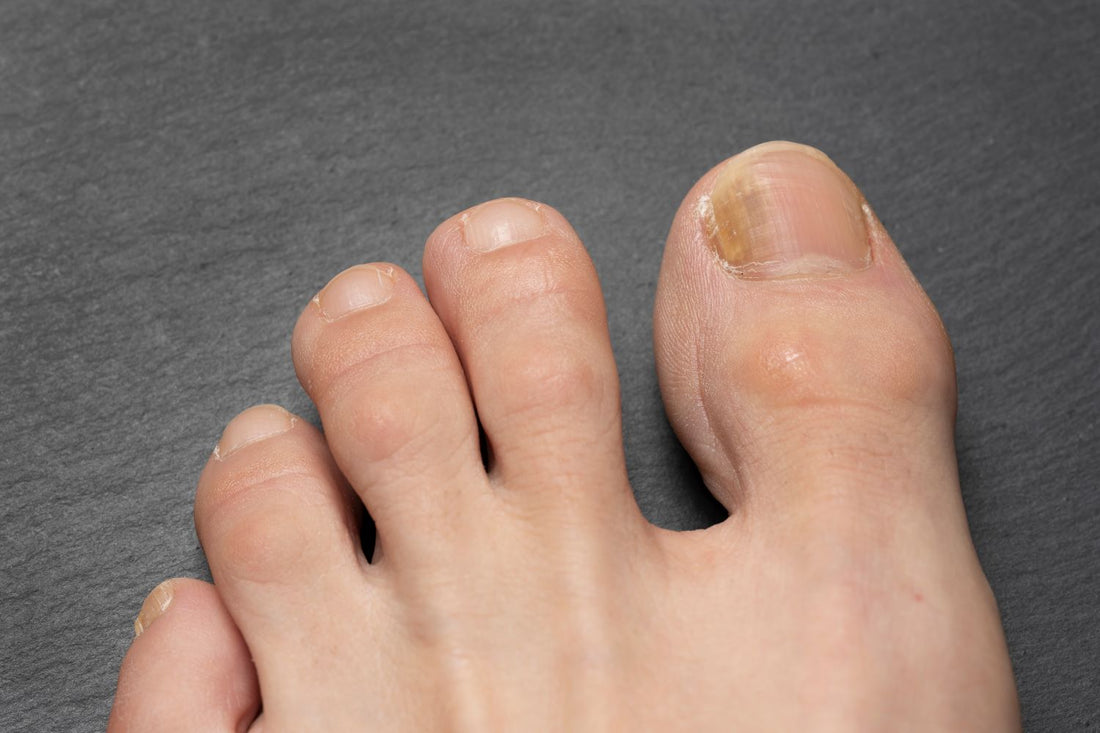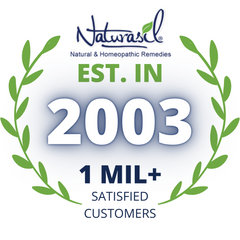¿Qué es una infección por hongos en las uñas?
La tiña ungueal es el nombre que recibe una infección micótica de las uñas, que suele aparecer en las uñas de los pies. Esta afección es causada por un tipo de hongo llamado dermatofitos (más comúnmente, se trata de dos cepas de hongos conocidos como Trichophyton rubrum y Trichophyton interdigital). [1]Estos dos tipos de dermatofitos causan entre el 80 y el 90% de las infecciones fúngicas en las uñas; el resto es causado por el crecimiento excesivo de un tipo de levadura. [2]
Los dermatofitos se desarrollan consumiendo la queratina de las uñas. Cuando los hongos invaden la uña a través del hiponiquio (la piel en la parte superior de la uña del pie, donde la uña se separa del lecho ungueal) y logran acceder a la uña (generalmente a través de algún daño en ella), es posible que comiences a ver síntomas de tiña ungueal. [3]
Aunque las infecciones por hongos en las uñas no suelen ser graves, pueden ser extremadamente desagradables y, en algunos casos, también pueden estar relacionadas con otros casos de infecciones por hongos. Los síntomas de la tiña ungueal son los signos externos de la infección por hongos en las uñas y los dermatofitos seguirán viviendo en las uñas (y posiblemente se propagarán a otras) hasta que se traten adecuadamente. La tiña ungueal también reaparece en hasta el 50 % de los casos, por lo que es esencial tomar medidas preventivas adecuadas para mantener las uñas libres de hongos.
Síntomas de una infección por hongos en las uñas
Estéticamente, existen dos variedades comunes de tiña ungueal, cada una con sus propios síntomas. En el primer tipo, conocido médicamente como tiña ungueal, distal o onicomicosis subungueal lateral - Primero notará una decoloración de las uñas afectadas. Esta cepa particular de tiña ungueal afecta las capas más profundas de las uñas de los pies y los síntomas pueden ser bastante graves. Es probable que las uñas de los pies se tornen amarillas o blancas, comenzando en una pequeña mancha que se extenderá con el tiempo. En casos más raros, la infección puede hacer que las uñas de los pies se tornen marrones o negras. A veces, las uñas pueden volverse más gruesas en algunos lugares o comenzar a desmoronarse, verse partidas o dañadas, y también pueden desprenderse del lecho ungueal. [4] Esto puede causar hinchazón y dolor en la piel alrededor de la uña del pie.
El otro síntoma estético de una infección micótica de las uñas es una formación opaca y blanca en las uñas que puede hacer que se vean turbias. En el caso de este tipo de infección micótica de las uñas, conocida médicamente como onicomicosis superficial blanca - Los dermatofitos han invadido la capa superior de la uña del pie (la capa dorsal). Si se puede raspar este crecimiento fúngico blanco, esto indica que los dermatofitos están afectando solo las capas superficiales superiores de la uña. Si no se puede raspar el crecimiento, entonces los dermatofitos han comenzado a penetrar más profundamente en la uña. [5]
Lo más común es que la uña del dedo gordo del pie sea la primera en verse afectada, pero es probable que la infección se propague a otras uñas del pie, en particular si también están dañadas. [6] Si bien es raro que las infecciones por hongos en las uñas afecten las uñas de las manos debido a que estas tienen un mejor suministro de sangre y crecen más rápido, es posible, especialmente si se toca las uñas de los pies afectadas con las uñas de las manos. [7]
¿Qué causa una infección por hongos en las uñas?
Existen muchas formas de contraer una infección micótica en las uñas. Algunos de los factores de riesgo más comunes son:
- Daño preexistente en la uña o en el lecho ungueal. Esto se debe a que el daño en las uñas hace que los dermatofitos penetren con mayor facilidad en la superficie de la uña.
- Un caso de tiña del pie (más comúnmente conocida como pie de atleta). Si tienes un caso de pie de atleta, los dermatofitos ya viven en tus pies y proliferan en tus calcetines, por lo que tus uñas de los pies tienen más probabilidades de ser vulnerables a una infección por hongos.
- Caminar descalzo sobre superficies húmedas y comunes donde otra persona con la afección ha depositado sus propios dermatofitos. Los culpables más comunes son los vestuarios, las piscinas públicas y las duchas comunes. Los dermatofitos proliferan en ambientes cálidos y húmedos, por lo que es más probable que los contraigas aquí.
- Compartir toallas, ropa de cama, prendas de vestir, zapatos y cortaúñas o tijeras con una persona que tiene una infección fúngica en las uñas. Los dermatofitos pueden vivir en superficies duras y blandas durante períodos significativos, por lo que es más probable que los contraiga si está cerca de alguien que ya tiene tiña ungueal y comparte cama, toallas o ropa con él.
Un estudio descubrió que los hombres tienen más probabilidades de sufrir una infección micótica en las uñas que las mujeres. Se cree que esto se debe a que los hombres tienen más probabilidades que las mujeres de usar con frecuencia calcetines húmedos o sudados y zapatos cerrados. Estas son dos causas importantes de infecciones micóticas en los pies y las uñas de los pies, ya que los dermatofitos prosperan en condiciones húmedas y cálidas. Además, se informa que los hombres tienen más probabilidades de sufrir daños o traumatismos en las uñas o el lecho ungueal. [8] Debido a que el hongo que causa esta infección de las uñas prefiere vivir dentro de la uña, es probable que entre en la uña del pie si tiene daño en la uña. Por lo tanto, si sus uñas de los pies están partidas o dañadas y entran en contacto con dermatofitos, es más probable que contraiga una infección de las uñas por hongos. Esto también puede suceder si se hace pedicuras con regularidad, ya que algunos de los productos y técnicas causan daños en la uña o en el lecho ungueal.
La probabilidad de contraer una infección micótica en las uñas también aumenta con la edad. Aunque los niños a veces contraen una infección micótica en las uñas, es mucho más común en los adultos mayores. [9] De hecho, mientras que el 10% de la población general tendrá una infección fúngica en las uñas en algún momento, esta cifra aumenta al 20% en las personas mayores de 60 años y a la mitad de las personas mayores de 70 años. [10] Es probable que esto se deba a que el crecimiento de las uñas se ralentiza con la edad y las personas mayores también tienen más probabilidades de sufrir traumatismos en las uñas. [11]Además, los fumadores también tienen más probabilidades de desarrollar una infección por hongos en las uñas. [12] Esto se debe al daño que los químicos de los cigarrillos causan a las uñas.
Cómo tratar una infección por hongos en las uñas
Cuando se trata de tratar una infección por hongos en las uñas y evitar la recurrencia de la afección, un enfoque consistente y específico es clave. Paquete de tratamiento para hongos en las uñas Naturasil ofrece una solución completa e integral para la tiña ungueal, con ingredientes totalmente naturales que están clínicamente probados para atacar eficazmente la infección por hongos en su origen.El uso de nuestros remedios homeopáticos naturales garantiza que su tratamiento sea seguro al evitar los químicos agresivos presentes en muchos remedios de venta libre y sus efectos secundarios asociados.
El paquete Naturasil consta de dos productos: nuestro Jabón medicinal para hongos en las uñas y nuestro Aceite para hongos en las uñasEl jabón utiliza una combinación suave pero eficaz de ingredientes antimicóticos naturales y aceites esenciales que combaten los hongos en las uñas mientras limpian y enriquecen profundamente la piel. Lavarse bien las uñas, los dedos de las manos y de los pies al menos dos veces al día durante 4 a 10 días ayudará a combatir los hongos en las uñas, evitando que sigan creciendo y deteniendo su propagación. Una vez que la uña haya crecido por completo, los síntomas de la infección por hongos desaparecerán. El uso continuo del jabón tendrá un efecto preventivo.
Para un tratamiento completo, utilice nuestro Aceite tópico para hongos en las uñas en las zonas afectadas de las uñas. El aceite es fácil de aplicar con el pincel aplicador, lo que ofrece una solución específica que complementa los efectos más amplios del jabón. Debe aplicar el aceite tres veces al día hasta que el hongo desaparezca, y el aceite debe aplicarse en la parte superior de la uña y debajo de ella siempre que sea posible. El aceite de hongos natural mejorará la salud de las uñas y reducirá la decoloración causada por la tiña ungueal, con resultados en tan solo dos semanas. El tratamiento debe continuar hasta que las uñas estén completamente libres de hongos para evitar la recurrencia de la afección.
Existen muchas medidas que puede tomar para prevenir los casos recurrentes de tiña ungueal. Entre ellas, se incluye el tratamiento de otras afecciones fúngicas, en particular la tiña del pie (pie de atleta), lo antes posible. Paquete económico para tiña Contiene dos productos que actúan eficazmente sobre los casos actuales de pie de atleta y, cuando se usan de manera constante, previenen su recurrencia. Jabón de azufre y lavanda Aprovecha las propiedades antimicóticas naturales del azufre para limpiar las zonas afectadas, mientras que el aceite de lavanda proporciona una frescura duradera. Tiña tópica Aceite Proporciona un enfoque potente y específico para combatir la infección fúngica desde su origen. Alivia la picazón y el malestar mientras se cura la infección.
También se pueden prevenir otros casos de infecciones fúngicas en las uñas mediante una determinada higiene y cuidado de las uñas. Procura mantener los pies limpios y secos tanto como sea posible y ponte calcetines limpios y nuevos a diario para evitar las condiciones cálidas y húmedas en las que los dermatofitos pueden multiplicarse. Mantener las uñas de los pies cortas también puede ayudar a proteger el hiponiquio, la parte del dedo que es vital para mantener las bacterias y otros microbios fuera de las uñas de los pies. Puede ser útil llevar zapatos abiertos para aumentar la circulación del aire alrededor de las uñas y evitar los zapatos estrechos y de tacón alto, ya que pueden restringir, ejercer presión y dañar las uñas de los pies. Evita llevar zapatos viejos y compartir productos para el cuidado de los pies y las uñas con otras personas que tengan la afección. Después de tratar las uñas fúngicas, asegúrate de limpiar bien las tijeras o cortaúñas para evitar una nueva infección.
[1] Asz-Sigall, D., Tosti, A. y Arenas, R. (2017). 'Tinea unguium: diagnóstico y tratamiento en la práctica.' Micopatíasa, 182, 95–100.
[2] Perea, S., Ramos, MJ, Garau, M., González, A., Noriega, AR, y del Palacio, A., 'Prevalencia y factores de riesgo de tinea unguium y tinea pedis en la población general en España.' (2000) Revista de microbiología clínica, 38(9).
[3] Piraccini, BM, y Alessandrini, A. (2015). 'Onicomicosis: una revisión'. Revista de hongos, 1(1), 30-43.
[4] Ibídem.
[5] Ibídem.
[6] Perera y otros, 2000.
[7] Westerberg, DP, y Voyack, MJ (2013). 'Onicomicosis: tendencias actuales en diagnóstico y tratamiento'. Soy un medico de familia, 88 (11), 762-770.
[8] Perera y otros, 2000.
[9] Gill, D., y Marks, R. (2002). 'Una revisión de la epidemiología de la tiña ungueal en la comunidad'. Revista Australasia de Dermatología, 40(1), 6–13.
[10] Westerberg y Voyack, 2013.
[11] Perera y otros, 2000.
[12] Westerberg y Voyack, 2013.








